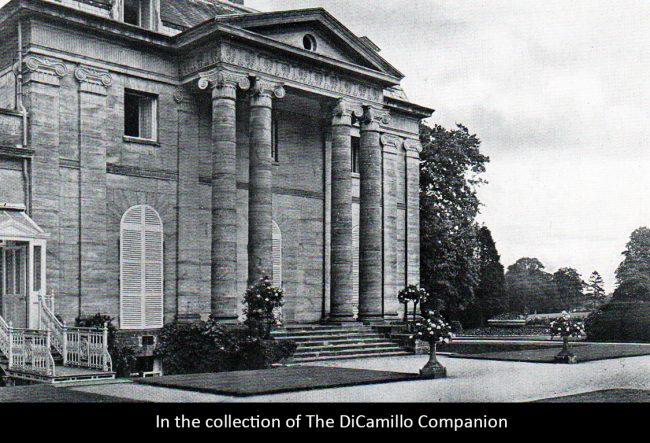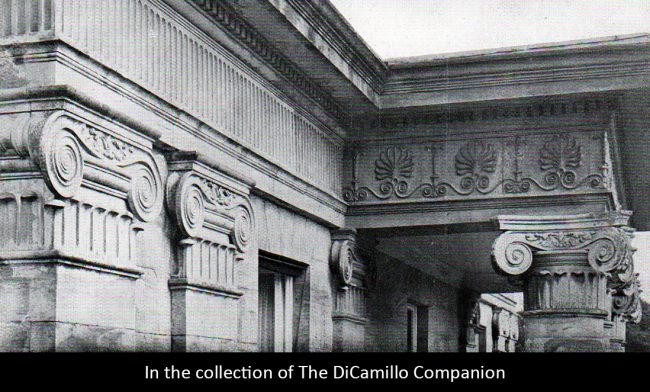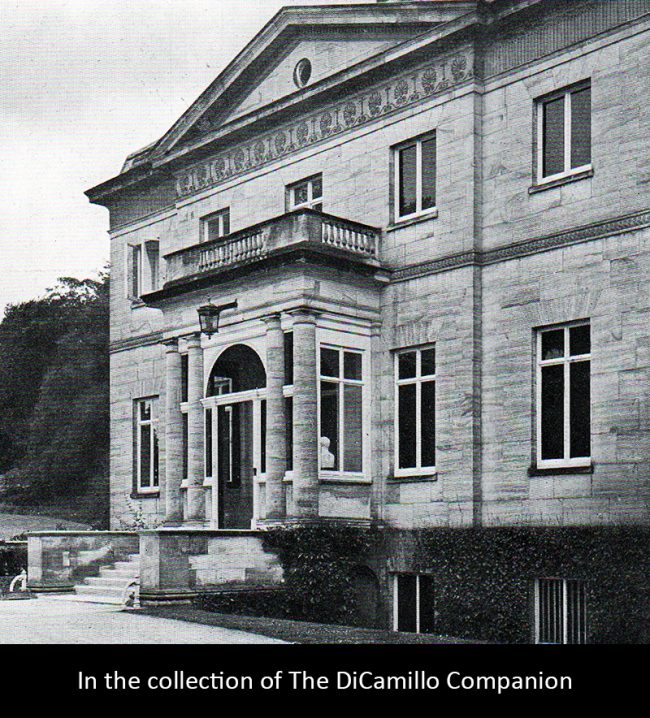
The garden facade from a 1915 photograph

Detail of the garden facade entablature from a 1915 photograph

The entrance facade from a 1915 photo
Built / Designed For: Dr. John Turton
House & Family History: Brasted was designed by Robert Adam (it is one of only two Adam houses in Kent, the other being Mersham-Le-Hatch) for John Turton (1735-1806), court physician to George III. Turton was at the center of the elite in late 18th century England and is mentioned in the letters of Horace Walpole and David Garrick. The house is a five-bay Palladian villa of two stories built of Tunbridge Wells sandstone between 1784 and 1785. Inside there are two panels of Chinese wallpaper depicting scenes of everyday life, the gift of George III, who received it himself as a gift from the emperor of China (some of the wallpaper has been removed to the Kent Historical Museum). Brasted is noted for its giant portico with coupled Ionic columns and its pronounced anthemion frieze. It had a number of 19th century additions and alterations, including an extension of the House and the addition of a balustraded terrace (early 19th century), the raising of the roof in the mansard style and the insertion of round dormer windows (1871), and additions on the western side of the house in the French Chateau (Renaissance) style, to the designs of Alfred Waterhouse (late 19th century). Brasted is most famous today as the residence, during 1840, of Napoleon III before he became emperor of France. In 1853 Willing Tipping purchased Brasted Place, together with approximately 300 acres, for £20,000 (approximately £14 million in 2012 values, using the labor value commodity index). Tipping was a Quaker from Liverpool who had made a fortune in the corn trade; it was Tipping who contracted with Alfred Waterhouse to repair the house and design the 1871 additions. H. (Henry) Avray Tipping (1855-1933) grew up in Brasted Place. Tipping worked briefly as a university lecturer before joining the staff of the "Dictionary of National Biography"; however, he is most famous today for his articles and books for "Country Life" magazine. His main interest was garden design (he worked as a garden designer in the Arts & Crafts style and was friends with Gertrude Jekyll and Harold Peto) and it was from this interest that his first articles for "Country Life" sprang in the early 20th century. In 1907 Tipping became the architectural editor of "Country Life." He ultimately became one of the leading authorities on the history, architecture, furnishings, and gardens of country houses in Britain, publishing many books on the subject, including "Grinling Gibbons and the Woodwork of his Age" (1914), "English Gardens" (1925), "Old English Furniture" (1928), "English Homes" (1929), and "The Garden of Today" (1933).
Garden & Outbuildings: The lodge and entrance gateway are both Grade II-listed. Garden urns from Brasted Place were installed by Avray Tipping in the garden at Mounton House, Monmouthshire, in the early 20th century.
Architect: Alfred Waterhouse
Date: 1871Country Life: Jun 12, 1915.
Title: Edwardian Country Life: The Story of H. Avray Tipping
Author: Gerrish, Helena
Year Published: 2011
Reference: pgs. 16, 17
Publisher: London: Frances Lincoln Limited
ISBN: 9780711232235
Book Type: Hardback
Title: Country Houses of Kent
Author: Oswald, Arthur
Year Published: 1933
Reference: pgs. 65-66
Publisher: London: Country Life Ltd.
ISBN: NA
Book Type: Hardback
Title: Biographical Dictionary of British Architects, 1600-1840, A - SOFTBACK
Author: Colvin, Howard
Year Published: 1995
Reference: pg. 60
Publisher: New Haven: Yale University Press
ISBN: 0300072074
Book Type: Softback
House Listed: Grade I
Park Listed: Not Listed
Past Seat / Home of: John Turton, 18th century. Louis-Napoléon Bonaparte, later Emperor Napoleon III, 1840. H. Avray Tipping, 20th century; Tipping family here from 1853 until the 20th century.
Current Ownership Type: Individual / Family Trust
Primary Current Ownership Use: Private Home
House Open to Public: No
Historic Houses Member: No